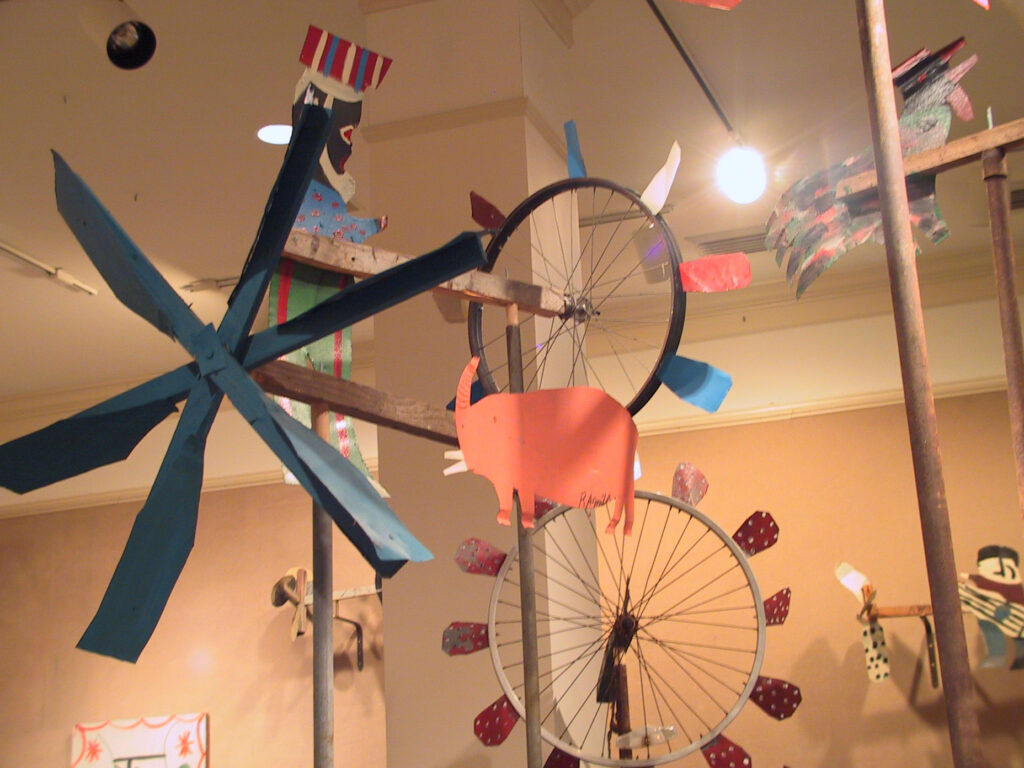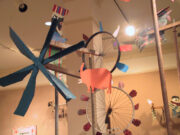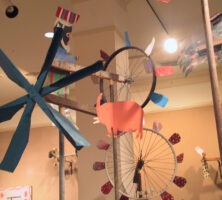R. A. Miller, a resident of Rabbittown, an unincorporated community north of Gainesville, was one of the state’s enduring self-taught artists, noted for his “whirligigs,” or metal cutout figures, and drawings, which typically feature animal or human figures and short inspirational messages. The best of his flat cutouts and drawn figures recall the expressive economy of such self-taught artists as Bill Traylor of Alabama.
Born on July 22, 1912, on the property where he lived for most of his life, Reuben Aaron Miller worked in cotton mills, farmed, and served as a preacher for the Free Will Baptist Church. When chronic eye problems began to limit Miller’s activities, he started making whirligigs to pass the time.
Although Miller’s early whirligigs sometimes featured mechanical figures, most were decorated with flat animal or human shapes, cut from tin and painted in enamel. Miller typically attached these cutouts to horizontal wooden supports, ranging from standard two-by-two lumber to salvaged furniture arms and legs. Tin paddles were cut, painted, and attached to wooden cross forms or bicycle wheels to provide surfaces for the wind to catch. By the mid-1980s Miller’s yard was a spectacle—a hilltop field of hundreds of spinning windmills. His animated environment attracted frequent visitors, including Athens rock group R.E.M., who in 1984, with painter and filmmaker James Herbert, filmed a twenty-minute video, Left of Reckoning, on Miller’s hilltop.
After folk-art dealers and collectors began to purchase Miller’s inexpensive whirligigs in large quantities, the artist started to make and sell cutout figures independent of the whirligigs. The best of Miller’s tin cutouts are gracefully abstracted and animated in gesture. His animal images range from bluebirds, chickens, pigs, and snakes to a variety of dinosaur types, inspired by nature programs on television. Human figures include red devils, angels, such American cultural icons as Uncle Sam and Elvis Presley, and less well-defined characters that sport hats, cigars, or red claws. Miller’s most frequent image is a figure emblazoned with the words “Blow Oskar,” a reference to the artist’s cousin, who would blow his car horn while driving past Miller’s property. Cutout shapes of churches, American flags, and crosses decorated with birds and angels also figure heavily in Miller’s work. In later years Miller’s popularity, combined with his failing eyesight, forced him to rely on assistants to paint his cutouts.

Photograph by Sarah E. McKee, New Georgia Encyclopedia
In addition to whirligigs and cutouts, Miller produced paintings and drawings in enamel or marker on masonite. These works include similar human figures, animals, and dinosaurs, which share space with such short inspirational messages as “Lord Love You” and are surrounded by simple decorative borders.
Miller’s work has been included in such exhibitions as Outside the Mainstream: Folk Art in Our Time at the High Museum of Art in Atlanta (1988) and Passionate Visions of the American South at the New Orleans Museum of Art in Louisiana (October 1993-January 1994). Further exhibitions, the inclusion of his work in museums’ permanent collections, and articles in such international publications as Raw Vision have contributed to Miller’s status as an elder statesman among Georgia’s self-taught artists.
In 2004 Miller lost his sight to an eye infection and moved to a nursing home in Commerce, where he died in March 2006. The month before his death, an exhibition of his work entitled R. A. Miller: A Tribute opened at the Brenau University Galleries.






